Sunday June 29, 2014
Fort Wilkins State Park
Copper Harbor, Michigan
Our campsite is just a short walk from Fort Wilkins.
We have not been over to the fort at all since we’ve been here and as tomorrow is our last day, this is our last chance. There is a longer route there via a nice lake side trail that goes from the campground, out by the lake and then over to the end of the fort opposite the campground. So we will take the long way around.
Lake Fanny Hooe, whom we have not spent nearly enough time with, is just steps away from our site. (the name still makes me laugh, poor girl). It looks like we are not going to get our kayaks out there for a paddle around to take a better look. Even with 5 days here and the full days we’ve had, we are out of time.
Even closer to us than the lake is one of our neighbors whose little trailer I just love, especially the name. We once had two burros at the farm, Fred and Ginger, they were great personalities.
The trail begins right off our campground road. It’s another one of the northern woods trails that are so wonderful.
We cross Route 41 from one deeply wooded path to another and are soon walking along next to Lake Superior with great views through the trees.
The trail ends at a little park across the road from the far entrance to the fort.
Here there is another set of information panels about another shipwreck.
Long story short (or can I really do that), it seems that near this spot on September 20, 1844 the ship John Jacob Astor was at anchor while crewmen maneuvered small boats to unload its cargo. In mid afternoon sudden gale force winds ripped the vessel from its anchorage. Remember the size of that anchor at the Eagle Harbor Light? Those must have been SOME winds.
When one anchor broke free, the Astor whipped wildly about on her second smaller anchor until, in the early morning darkness, it failed to hold. Rough seas heaved the Astor upon the rocks and battered her hull.
At this point the fort which is only 200 yards away is just an encampment. Squads of soldiers struggle all night in torrential rain to tend bonfires and helplessly keep watch over the stricken ship and its crew.
The loss of the Astor is a serious blow as the western settlements are stockpiling supplies for the winter. Those supplies are now lost. There is concern that the Fort Wilkins Garrison can only survive the winter by strict rationing which they do.
In the weeks ahead, tireless efforts by the captain and crew fail to free the Astor. Miners from the Lake Superior Mining Company blast away rock in attempts to make her level, but without jacks to raise her up, the captain is unable to pull her up on dry land for repairs. The captain refuses to leave the ship before trying again in late January to save her. Battered by surf and ice, the John Jacob Astor breaks apart in February 1845. In the spring they set fire to the ship and collect the remaining metal. End story.
The park is right at the mouth of Lake Fanny Hooe Creek so we follow her up stream toward the fort where she ripples along heading for Lake Superior.
According to the map, we head into backwards. What else is new?
The main entrance to the fort complex is off of the parking lot at the map’s lower right. The campground has a nice short trail coming in along the lake that completely by passes the parking lot and takes you directly to the row of married enlisted men’s log cabins. We’ll take that on our way back.
Now, we are going in the back gate right by the beautiful stone bridge. You are here on the map shows where we begin our tour.
There are pros and cons to our method. If you do it the “right way” you get to see the film first and it is very informative if you know nothing about the fort. Or you can learn as you go and when you see the film you will recognize places you’ve already seen.
This is the world of 1870.
We are at the rear of the Officer’s Quarters. Their privies are the small huts behind. This is one of the most detailed restorations I have been to. I think during the height of their summer season when there are many reenactors it could feel like a Frontier Fort version of Williamsburg.
The first buildings we go in are the guardhouse and powder magazine. The guardhouse served as a checkpoint for persons entering the fort and as a prison. So see, we actually have come in the right gate. We are entering the fort :-) Built in 1844 it has a guard room, a prison room and 3 cells. I couldn’t quite figure out what the prison room was for unless it was a sort of “holding tank”.
Guards patrolled the gate, guarded the prisoners and watched for fires. The guard detail was 5 soldiers who worked a 24 hour shift together. The shift was divided into blocks of time called “reliefs”. Two hours on, 4 hours off.
The interior door in the guard house goes into the jail area. There are the three cells each with a pad lock. At the end of the hall is the prison room. I’m sure one of my commenters is going to tell me what this was for if I am wrong.
Here is an unoccupied cell. Apparently they didn’t want their prisoners to be too comfortable. No library, exercise yard or even window to the outside here.
Here is an occupied cell.
Looks pretty guilty doesn’t he?
Good thing I’m no law breaker, I’m not tall enough to look out of the “window”
.
The powder magazine had all kinds of ammunition and fire arms of course.
I guess they were expecting to really have to defend themselves. Turns out that wasn’t the case.
The fort wasn’t a fort for very many years.
Next we come to the Officer’s Quarters. There are quite a few. Some are furnished in period furniture and appear as though the family just stepped out. Others are used for display purposes.
The first one we go into is the story of the short life of the fort as a military fort and its ultimately becoming a state park.
When copper was discovered here and the country’s first “gold rush” brought fortune seekers from all directions, the fort was built to protect against possible disorder and violence and to protect the cargo being shipped out. Some Ojibwas objected to the Treat of La Pointe that ceded this land of theirs to the United States in 1842.43.
However the fort proved unnecessary as neither the Ojibwa or the miners created problems.
The fort was situated between Copper Harbor on Lake Superior and the North Shore of Lake Fanny Hooe. The army built 27 structures here. In 1846 with the US invasion of Mexico the troops were needed there. The fort was temporarily abandoned with a single caretaker Sergeant William Wright. When he died in 1855 the fort was rented for the creation of a health resort but that plan failed when its founder died in 1861. The fort was reoccupied from 1867 to 1870 when it was permanently abandoned. I’m thinking this was a huge expenditure of money and creation of buildings to use for only 5 years. Guess they didn’t know that then.
The fort sat idle and began to fall into ruin, as you can see in the picture above, before the state acquired it in 1923 and made it into one of the earliest State Parks. It is the only example of an authentic wooden fort east of the Mississippi.
I’ll look at archeologists a little differently after this.
In another of the quarters is an excellent exhibit on the archeology used to restore and rebuild the buildings. One of the places which yielded a great deal of information was under the outhouses. Eeewwww. I know by now everything organic has decayed but still…..
Apparently people put all sorts of “trash” down the hole. This gives me a whole different perspective on archeologists. Did Indiana Jones really do this?
These very privies are out back of the officer’s quarters.
The officers brought their civilized finery with them here into the far remote north.
Next we go into several of the Officer’s quarters filled with period furniture. During the summer, July and August, there are period reenactors in these rooms.
Is this just ANOTHER legend of Fanny Hooe or historic fact?
One very important thing I learn here about the officers at the fort is that they named neighboring lakes in honor of women at the fort. It turns out that the story of the lost Fanny Hooe is, as I suspected, untrue. Fanny Hooe was the sister of one of the officer’s wives and came to stay with them so that she would have some company out here in the wilderness where there was nothing. That part of the legend is true. Fanny was popular among the men apparently and they named the lake after her. Other lakes were named after other women but those names were changed for some reason. Lake Martha Stevenson was renamed Lake Manganese and Lake Clara Geisse is now known as Mud Lake. Poor Clara what a slap in the face.
So is this fact presented in the historic area of Fort Wilkins another legend? Why would Fanny get to keep her lake name but Martha and poor Clara lose theirs? Someone actually did some historical research on Fanny’s genealogy and wrote a book about it which is for sale in the Park store. Don’t you love this stuff??
The copper boom is really what created the fort and copper is still all over the Keweenaw.
Another of the quarters tells all about the copper boom and has displays of the rocks we’ve been seeing on the beaches. Apparently many have copper in them. Who knew? Guess we’d better look more closely. Everyone else seems to be looking for agates.
Now for the really really fun parts.
Among the most interesting displays, is one where we learn facts about the men who were soldiers here and their lives at the fort. In total 271 enlisted men served at Fort Wilkins between 1844 and 1870 although that was really only 5 years.
Records for all but 10 have been found so they know what happened to them. That’s amazing. Less than 4% reenlisted. Being out here in this remote place with nothing but bugs for part of the year and cold for the rest seems to have been pretty discouraging even for a short period of time. We also learn that the huge majority of soldiers here were immigrants mainly from Ireland.
In one display room, we are able to push buttons and hear the bugle calls for their very regimented day. It seems that there was a call every two hours for something. Reveille, drill, sick call, breakfast call, fatigue call, squad call, orderly call, assembly call, dinner call, Fatigue Call, Assembly Call, Retreat, Tattoo.
Can you even imagine how much you’d like to stuff a rag in that bugle after a few days of this every 2 hours?
It was fun pushing the buttons and hearing the bugle, the fife and the drum. There was even a drum head and sticks so you could play along if you had a clue how to.
We this section by playing the Fort Wilkins game where you try to get your ship with supplies to the fort. This was a serious challenge both in real time in 1844 and today as we kept having one set back or catastrophe after another strike our boats. After a fierce race, David got there before me by two squares.
The winner gloats and points to his winning marker.
Nearly every room that was used in the 27 buildings was on display.
I’m not going to show you all of them but among them were the physician’s room, the orderly’s room, the enlisted men’s barracks, and the “mess” where they ate.
After the seeing the barracks, which like the officer’s quarters, has one building on each side of the open ended courtyard, we step out onto the lawn to look at the really lovely setting and grounds. The buildings, placed in a horseshoe shape all face Lake Fanny Hooe.
The fort required quite a few support systems.
We leave the main fort and visit other separate buildings, blacksmith’s shop, the bakery and the Sutler’s Building. All the shops have authentic equipment.
Can you read the recipe? To make bread for 120 soldiers, the baker used 120 pounds of flour, 7 gallons of water, 1 gallon of prepared yeast, 1 1/2 pounds of salt. Each man received one 18 oz loaf daily. Bread was not served fresh but left to stand 24 hours to “improve digestion”. The bowl I’m holding would have held the salt.
Here is where the yeast would rise.
And here is where they would bake it.
I had no idea what a Sutler was until I went into his store. He’s a civilian merchant who sells provisions to an army in the field, or in quarters. I guess we’d call him concessionaire now.
How about a nice wooden canteen??
Or some shorts? What are they? Well………….
I tried my hand at the sutler’s job and was only able to sell my client a glass of whiskey from the counter keg.
I’m shocked to find the married enlisted men are quartered outside the fort.
As we walk out of the gate nearest the campground to leave, we find that married enlisted men’s quarters are outside the protection of the fort. Theirs were log cabins not frame buildings like those inside the fort. Their wives normally worked as laundresses for the fort. The officer’s wives of course were ladies and did not work at all.
No mention was made, that I could find, of this pretty major socio economic prejudice. I have never been in the military or had any really close friends who were and talked about their experiences but I certainly hope that the stigma of officer and enlisted is not handled the same way today.
David’s battery died at this point so I can’t show you the stark difference between the inside of the officers’ quarters and the enlisted men’s. But you can see from the buildings there is a big difference. The log cabins are duplexes. Each family had one room. Each officer’s quarters was 4 rooms at a minimum and larger as your rank increased.
With that, our self guided tour is over. Whoever the curators are for this exhibit, they have done a fantastic job of presenting a ton of information in an interesting and captivating way. All ages would find many things here to enjoy.
I never imagined I would like visiting a fort as much as I did this one. We thought we’d be gone a couple of hours for the hike and the fort; we were there until about 6:00 at night. Admission is free with your campsite.







































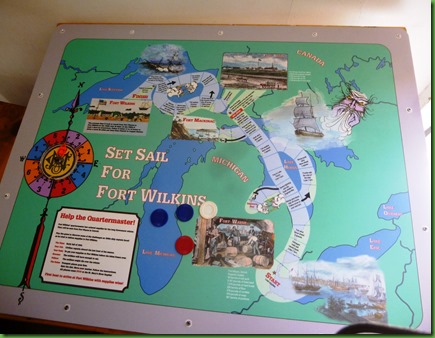



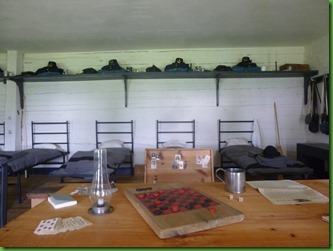


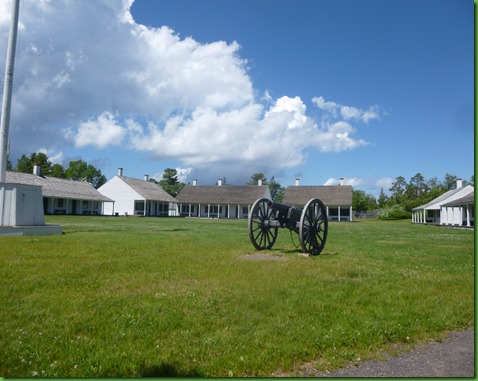




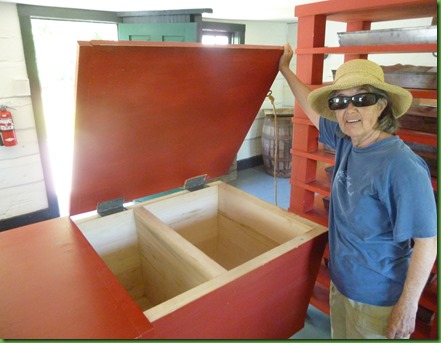

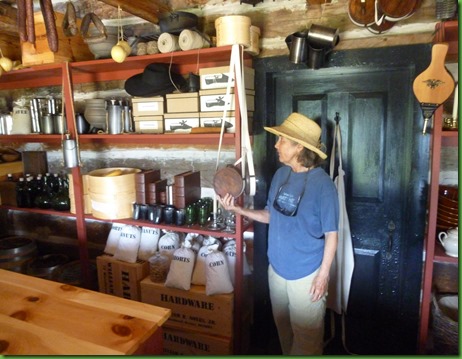
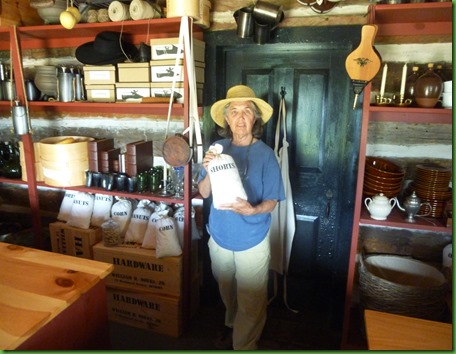


But you did not meet one enemy!
ReplyDeleteThanks for the info, it's a place we need to add to our bucket list.
ReplyDeleteI worked in the Sutler's Store at Ft. Pulaski, GA for 3 months and love the store and every inch of the Fort.
ReplyDeleteMaybe the prison room is where the prisoners were interrogated and tortured! And as for spending all that money for only 5 years' use shouldn't surprise anyone - it happens all the time.
I think of you and your stay along Lake Superior as I am reading a new novel. It is called A Superior Death by Nevada Barr. The main character Anna Pigeon is a NP Ranger. She is stationed on Isle Royale NP for the summer. There are a series of stories with this same main character and each is at different NP. The author was a NP Ranger. Interesting following your blog and reading this book!
ReplyDeleteI've read Barr's work and liked it. That particular one was rather chilling. We went to Isle Royale on our last trip to Copper Harbor but not this time. If you've never been, save your pennies and spend a few days.
DeleteThanks, Sherry! We are heading that way and trying to decide where to stop. You have left me wanting to see so many places but I want to be in Glacier by mid August. So we will only have a couple weeks at the most.
DeleteGreat tour, they should hire you as a guide! Nice that you could do a detailed tour, too many museums have everything roped or glassed off.
ReplyDeleteI bet the jail was used more to dry out drunken soldiers than anything else. Poor guys didn't have much to look forward to in the way of recreation.
I have to ask, did Ginger wear high heels and dance backwards with Fred?
I wonder HOW popular Fanny was :-) Nice tour of the fort, very well done!
ReplyDeleteThis tour is amazing!!! Certainly a place that deserves a couple week stay. You two have done so much and still have not completed everything you wanted. I do think that inmate is a shifty looking fellow;o)) Keep having fun as we are enjoying your travels!!
ReplyDeleteBill wants to know how you're making out with the solar panels. Do you have occassion to use them??
Just catching up, looks like you've been having a good time, never visited a museum with out having barriers in our way of the exhibits. Have a safe 4th while the craziness abounds.
ReplyDeleteThoroughly enjoyed the tour! Since no real threat ever developed I like to think the enlisted men and their wives had more fun not being under the strict eye of the officers during their "down" time :-).
ReplyDeleteHope your 4th is fun and safe!
What a fascinating fort! And so cool that you could walk there from your campground. When we camped at Fort Davis Mountains (Texas) we hiked a couple of miles over the mountains to Fort Davis; it was very interesting and the exhibits were great, but nowhere near the detail of what you experienced at Fort Wilkins. Love the photo of you playing Sutler!
ReplyDeleteThat is an amazing restoration job and you provided a very informative tour, Ranger Sherry.
ReplyDeleteGreat tour! Interesting history and impressive that they could piece it together and rebuild. I was not surprised to hear only 4% reenlisted - with that bugle, I would be saying "no I'm not staying...get me away from that bugle!!!" Haha! It would be neat to see the reenactments! I would have enjoyed playing the board game, of course - interactive exhibits are the most fun :)
ReplyDeleteVery behind on reading blogs from when I was on vacations. This is one more place I've added to the list for our late September visit to the U.P.! Hopefully we can stay in the campground too. Don't know when it closes for the year. More research is required!
ReplyDeletemy father took me to fort wilkins in 1955. I was 7 yrs. old. We were the only ones there. all of he restoration had not started at that time. Do they still have the metal marker for fanny hooe. I remember reading about how she disappeared at 16 years of age while picking berries. the marker was old at that time. I would guess about 30 to 40 yrs. old. There must be some truth to the story as that story has existed for around 90 years I would guess by the age of that old marker. I am going to order that book. I was fascinated by the story than, as well as today. Thank you for posting those pictures. I enjoyed them so much. You helped me to revisit the past.
ReplyDelete